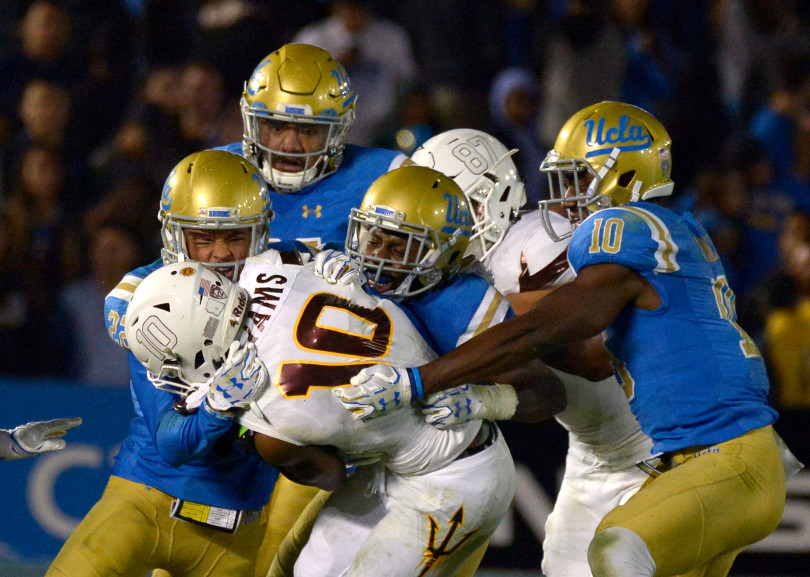
UCLA defenders Nate Meadors (front, left), Adarius Pickett (center) and Colin Samuel (right) tackle Arizona State wide receiver Kyle Williams (10) for a loss of yards in the first half of a NCAA college football game at the Rose Bowl in Pasadena, Calif., Saturday, Nov. 11, 2017. (Photo by Keith Birmingham, Pasadena Star-News/SCNG)
UCLA is still last in the country in rushing yards allowed at 302.3 yards per game and has already surpassed the school record for rushing yards allowed in a season with two games left, but Jim Mora said he is starting to see improvement.
The UCLA head coach pointed specifically to a decreasing number of big runs allowed in recent weeks. Indeed, the Bruins have allowed only five runs of 21 or more yards in the past four games and none longer than 37 yards. This defense allowed at least one run of 66 yards or longer in each of the first four games of the year.
So if UCLA has finally been able to cut down on the explosive plays, then why aren’t the Bruins taking bigger steps forward when it comes to its rushing defense?
Here’s a look at how teams have gained yardage on the ground against UCLA this year. Each game is broken down into runs of different length (from negative-yardage rushes to rushes of 21 yards or longer) and each bar represents the percentage of rushes during that game that went for each distance. For example, 12.6 percent of Texas A&M’s runs against the Bruins went for negative yardage (as shown by the first bright yellow bar).  A couple things to notice:
A couple things to notice:
- The red bar (rushes of 21 yards or longer) is at its lowest. This is a positive sign for the defense that suggests the open-field tackling issue is starting to fix itself, especially in the secondary.
- The purple bar (rushes of 4-to-6 yards) is rising steadily. So while the Bruins aren’t giving up the home run plays anymore, they’re still getting slowly worn down with repeated shorter runs. This could suggest that the defensive line is still struggling with some of its run fits, allowing rushers to break into the second level where the linebackers then clean up the tackles.
- The dark blue bar (11-to-20-yard runs) has been above 15 percent for the past two games after not reaching that level in any of the first eight games. This is also another contributing factor as to why the Bruins can’t seem to make more progress. Despite cutting down on the biggest runs, they’re still allowing big chunks of yardage, mixed in with repeated short-to-mid-range gains.
